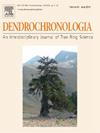炎热的冬春干旱加速了罗马尼亚干旱地区边缘有花序栎树(栎)种群的生长衰退
IF 2.7
3区 农林科学
Q1 FORESTRY
引用次数: 0
摘要
有梗栎(Quercus robur L.)是欧洲的主要树种,但近年来在一些地区面临着生长衰退和枯死事件,造成了经济和生态系统的损失。在罗马尼亚东部自然分布的东南边缘,自20世纪80年代以来气温不断上升,向更温暖和更干旱的条件转变,增加了蒸发需求,引发了增长下降。我们分析了6个橡树林(333棵树)的适应潜力,这些橡树林的树龄在97到233年之间,分布在3个潮湿和3个干燥的地点。结果表明,1985年以后,气候变暖加剧,气候增长相关性不稳定,存在一个断点。早春至夏季湿润的土壤条件有利于生长;相反,较高的蒸发需求与较温暖的条件和更大的潜在蒸散发有关,从而减少了生长,特别是在潮湿地区。1985年以后,干旱胁迫导致干地晚木宽度减小。近几十年来,生长与夏秋干旱之间的关系在所有地点都有所加强。温暖的春季环境对橡树的生长产生了负面影响,尤其是晚木的生产。湿样地的恢复力指数较低,并且在1985年后逐渐降低。干燥地区生长缓慢的树木表现出生长下降,这可能是即将枯死和树木死亡的早期预警信号。相比之下,湿地生长迅速的树木表现出持续的相对生长改善,这归因于树木的年龄和大小效应。1985年以后,随着冬春干旱的升温,有花序栎在靠近东南分布极限的干地更容易遭受干旱破坏。本文章由计算机程序翻译,如有差异,请以英文原文为准。
Hotter winter-spring droughts accelerated the growth decline of marginal pedunculate oak (Quercus robur) populations in dry sites from Romania
The pedunculate oak (Quercus robur L.) is a major tree species in Europe, but it has faced recent growth decline and dieback events in some areas resulting in economic and ecosystem losses. In the southeastern edge of its natural distribution in eastern Romania, rising temperatures since the 1980s, when a shift towards warmer and more arid conditions occurred, increased evaporative demand and triggered growth decline. We analyzed the adaptive potential of six oak stands (333 individual trees) with ages ranging between 97 and 233 years, located in three wet and three dry sites. Results showed unstable climate-growth correlations with a breakpoint after 1985 when climate warming intensified. Wet soil conditions from early spring to summer enhanced growth; on the contrary, a high evaporative demand linked to warmer conditions and greater potential evapotranspiration reduced growth, particularly in wet sites. After 1985, drought stress induced a reduction in latewood width in dry sites. The relationship between growth and summer-autumn drought intensified during the last decades in all sites. Warmer spring conditions negatively affected oak growth, particularly latewood production. Wet sites had lower resilience indices, and we also noted a post-1985 progressive reduction of growth resilience. Slow-growing trees from dry sites showed growth decline, which could be an early-warning signal of impending dieback and tree death. In contrast, fast-growing trees from wet sites showed sustained relative growth improvement, which was attributed to tree age and size effects. After 1985, the pedunculate oak is more vulnerable to drought damage in dry sites near the southeastern distribution limit in response to hotter winter-spring droughts.
求助全文
通过发布文献求助,成功后即可免费获取论文全文。
去求助
来源期刊

Dendrochronologia
FORESTRY-GEOGRAPHY, PHYSICAL
CiteScore
5.50
自引率
13.30%
发文量
82
审稿时长
22.8 weeks
期刊介绍:
Dendrochronologia is a peer-reviewed international scholarly journal that presents high-quality research related to growth rings of woody plants, i.e., trees and shrubs, and the application of tree-ring studies.
The areas covered by the journal include, but are not limited to:
Archaeology
Botany
Climatology
Ecology
Forestry
Geology
Hydrology
Original research articles, reviews, communications, technical notes and personal notes are considered for publication.
 求助内容:
求助内容: 应助结果提醒方式:
应助结果提醒方式:


